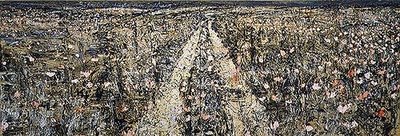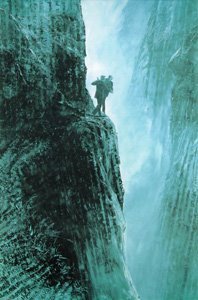Creating a Mood Board (3/14/2010)
My sister is an art director in London and I once sat at her enormous iMac as she showed me the mood boards she had created to develop a logo for our younger brother’s band. I think that mood boarding is a greatly underused tool by artists and writers. And I don’t just mean in the creation of serious works. I also mean in developing a website, a blog, branding your work, your gallery, and yourself as a writer.
Some days the energy of the art we love most is more present and we can sense clearly how deep its meanings go in us. It helps to have a quiet Sunday to do this. Today, I am thinking about three painters: one post-WWII, one still alive and kicking, and one from the turn of the last century. They are: Anselm Kiefer, the abstract expressionist; Mark Tansey, the postmodernist; and Jean Delville, the symbolist.
My Mood Board
Here are some of my personal favorite pieces of art.
First is Anselm Kiefer’s Bohemia Lies By the Sea, which at this size looks admittedly unimpressive. But you can still pick up on the three-dimensionality of the piece, how it does seem to stretch into the distance. And if you know a bit about Bohemia and it place in literature, then you know the mood and story behind this piece.
I was so moved by Kiefer that it once inspired a poem, which in turn inspired this blog about how moods in art can inspire the creation of more art. My poem is posted at my poetry blog: ninaalvarez.net.
There was once a time when I would have looked at “Bohemia Lies by the Sea” and seen only a muddy landscape. But the beauty of developing pathos through years of overwrought sensitivity is that those of us who look for it can begin to see pervasive human themes in something as mundane as wheel tracks running through a brown field.
Next is Mark Tansey’s Derrida Queries De Man.
I mean, come on. How often do us in love with literary theory get such a wonderful illustration of our heroes? Tansey is still living and has this wonderful American film quality style that he blends with the subtly surreal.
In him my intellect and humor are satisfied, and the mood is set through his use of the monochrome. I have struggled to define what it was about monochrome that made it so arresting. Maybe I still haven’t answered it, but perhaps it is because when natural colors are absent, we see form, shape, and composition more clearly. We are given the cue that we are to really look at this as a suspended moment, set apart from daily life.
And MILES apart from daily life resides the work of Jean Delville, the Belgian Symbolist.
My love for his type of work transverses visual arts into the literary. I, like many others, are rapt when we read Dante’s Inferno. Beautiful agony is depicted here in “Satan’s Treasures“ through the fantastical colors and shapes and images of this river of tortured souls.
First exhibited in 1895, the era of the Symbolists was one of heightened interest in the occult and the supernatural as a response to the materialism of the times.
I see Delville as a person of immense vision, able to see into the deepest dreams of the collective consciousness. Symbols are after all, with some exceptions, the language that we all share.
So, as a writer, I look at these artists whose work resonates with me: Kiefer with my sense of being, Tansey with my intellect, Delville with my fantasy, and if I hold them all together in my mind, it forms a sort of prism which can incite a world large enough for a novel, or precise enough for a poem.
So, if you are feeling like you need a jump start on your art, your writing, your blogging, your website, why not create a mood board of your own? You don’t need to write anything, just throw up three images that speak to you and see what happens.
Be good and write well,
Be well and write good,
Nina


